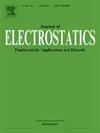提高从报废软管碎片中分离纺织纤维的摩擦静电分离效率
IF 1.9
4区 工程技术
Q3 ENGINEERING, ELECTRICAL & ELECTRONIC
引用次数: 0
摘要
典型的报废软管(ELH)回收步骤包括几个粉碎操作,以减小其尺寸并分解其成分。随后,可以采用各种工艺,如静电分离或其他分类方法,回收组成材料,这些组成材料可以在新产品中重复使用,从而有助于减少浪费,节约自然资源。本研究的目的是验证使用新专利的摩擦静电分离器分选聚对苯二甲酸乙二醇酯(PET)纤维和聚氨酯(PU)颗粒的可能性,这些颗粒是由一种重要的ELH减粒径操作后得到的产品组成的。摩擦静电分离器由改进的转筒式摩擦充电器和两对水平圆柱形旋转电极(长度:460 mm;直径:260毫米)连接到两个极性相反的高压源(±30千伏),这种配置与标准垂直电极系统完全不同。最初的ELH粉碎混合物含有大约40%的PET纤维和60%的PU颗粒,被引入摩擦充电器,该充电器由一个圆柱形筛子(长度:460毫米;直径:200毫米),旋转速度范围从5转/分钟到50转/分钟。摩擦增压器位于电极之间的空间,在它们之间的中距离,PET纤维或PU颗粒一旦充够电或极化就会被吸引到电极上。试验使用了几种配置的摩擦增压器,这些配置是通过在圆柱筛内添加减速弯并改变其倾角从0.2°到2.5°来获得的。通过使用两种不同类型的碎纸机获得两种不同尺寸的混合物,进行摩擦-静电分离过程。通过测量在电极处收集的纤维的质量并将其与处理后的ELH的质量进行比较,对结果进行评估。摩擦静电分离器的PET纤维回收率约为25%,纯度约为95%,使其成为回收此类废物中聚合物的有效解决方案。本文章由计算机程序翻译,如有差异,请以英文原文为准。
Improving the efficiency of tribo-electrostatic separation of textile fibers from shredded end-of-life hoses
Typical recycling steps of end-of-life hoses (ELH) include several shredding operations to reduce their size and break down their constituents. Subsequently, various processes such as electrostatic separation or other sorting methods may be employed to recover the constituent materials, which can be reused in new products, thus helping to reduce waste and conserve natural resources. The objective of this study was to validate the possibility of using a newly-patented tribo-electrostatic separator to sort the Polyethylene Terephthalate (PET) fibers and Polyurethane (PU) grains that compose the product obtained after the size-reduction operation of an important class of ELH. The tribo-electrostatic separator consists of a modified rotating-cylinder type triboelectric charger and two pairs of horizontal cylindrical rotating electrodes (length: 460 mm; diameter: 260 mm) connected to two high-voltage sources of opposite polarities (±30 kV), a configuration that is radically different from the standard vertical electrode systems. The initial mixture of shredded ELH, which contained approximately 40 % PET fibers and 60 % PU grains, was introduced into the triboelectric charger, which consists of a cylindrical sieve (length: 460 mm; diameter: 200 mm), rotating at speeds ranging from 5 rpm to 50 rpm. The tribocharger being located in the space between the electrodes, at mid-distance between them, the PET fibers or PU grains are attracted towards the electrodes as soon as they are sufficiently charged or polarized. The tests were carried out using several configurations of the tribocharger, obtained by adding chicanes inside the cylindrical sieve and varying its angle of inclination from 0.2° to 2.5°. Two mixtures of two different sizes, obtained by using two distinct types of shredders were subjected to the tribo-electrostatic separation process. The evaluation of the results was carried out by measuring the mass of the fibers collected at the electrodes and comparing it with the mass of the treated ELH. The tribo-electrostatic separator achieved a PET fiber recovery rate of approximately 25 %, with a purity of around 95 %, performances that make it an efficient solution for the recycling of the polymers contained in this class of waste.
求助全文
通过发布文献求助,成功后即可免费获取论文全文。
去求助
来源期刊

Journal of Electrostatics
工程技术-工程:电子与电气
CiteScore
4.00
自引率
11.10%
发文量
81
审稿时长
49 days
期刊介绍:
The Journal of Electrostatics is the leading forum for publishing research findings that advance knowledge in the field of electrostatics. We invite submissions in the following areas:
Electrostatic charge separation processes.
Electrostatic manipulation of particles, droplets, and biological cells.
Electrostatically driven or controlled fluid flow.
Electrostatics in the gas phase.
 求助内容:
求助内容: 应助结果提醒方式:
应助结果提醒方式:


